Monday, March 9th, 2020 by Julian Karsunky
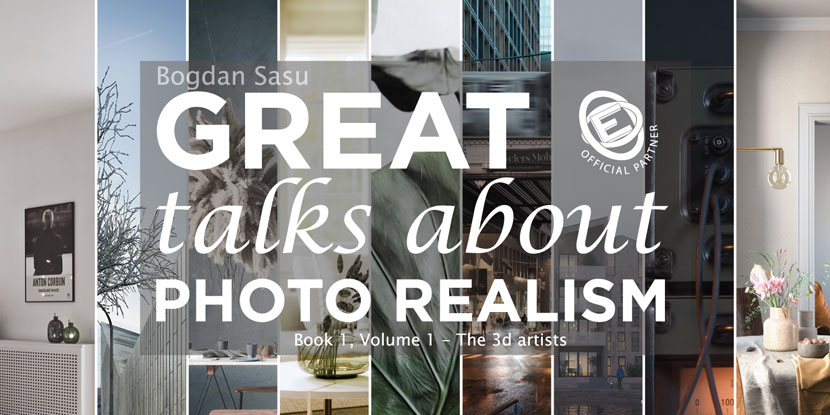
3D art as a medium is inherently digital. It is therefore not often that someone attempts to transfer CG imagery from the screen into the physical realm. Romanian archviz artist, visionary and author Bogdan Sasu has done just that with the recent release of his book project ‘Great Talks About Photo Realism’ (GTAPR). A concentrated effort by industry and community players, GTAPR showcases nine talented visualization artists from all over the world, with exclusive scenes offered online as a bonus for aspiring learners.
To celebrate the release of his book and our newfound partnership, we sat down with Bogdan to discuss his professional history as an artist, transitioning into authorship and future plans for GTAPR.
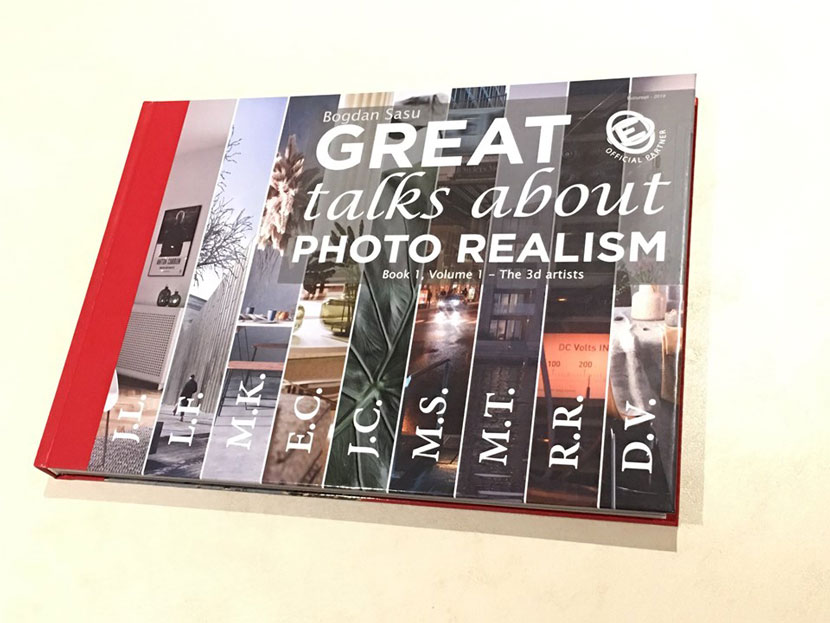 One book, nine unique stories – ‘Great Talks About Photo Realism’ by Bogdan Sasu.
One book, nine unique stories – ‘Great Talks About Photo Realism’ by Bogdan Sasu.
Hi Bogdan, thanks for joining us today! To start things off, please introduce yourself to our readers!
My name is Bogdan Sasu, I’m a 32-years-old archviz artist and, as of late, author from Bucharest, Romania.
Do you recall when and how you first consciously encountered CGI?
My interest in art started on a 2D plane, with drawings, to be more exact. As early as the age of five or six, I remember being obsessed with coloring books, I always tried to replicate the images. Since it was the mid-nineties, all I had at my disposal were pencils and paper. My father supported my interest and was the first to give me some pointers on how to draw and I’ve basically been hooked ever since. I continued drawing, at age seven I learned chip carving, at 11 I started to paint on wood, and over the years I’ve tried several other art forms. Finally, in 2009, I was first introduced to CGI. Once I realized these images were made using a computer, I was intrigued, and wanting to find out more, I began learning 3ds Max, my initial 3D software.
When did you decide to pursuit a professional career as a 3D artist?
Between 2009-2012, when I began following my newfound passion, the concept of being a professional visualizer or 3D artist was still foreign to me. I had heard of legends like Alex Roman, of course, and knew they were the absolute best in terms of 3D, so all I wanted was to work and reach similar results – although I knew that I was dreaming really big.
Being passionate about architecture and pursuing an education in this direction, I’ve sensed that 3D and architecture could give me a purpose; I was able to build worlds and that feeling alone is intoxicating for an aspiring artist.
After graduating from high-school in 2006, I was daring enough to apply at a local architecture studio. I say daring, because I literally just entered their offices, introduced myself to the secretary and told her I was interested in working there. After two days, they called me back and asked me to come in for a proper interview. I remember being very proud of my architectural drawings, sketches, my knowledge on perspectives and abilities in general, so I put together a portfolio and confidently went in for my first interview. However, it only took a single question to shatter my initial confidence and rethink my attitude, and that was: “what about computers, are you able to work in ArchiCAD?”
What training or education do you have?
Before receiving any formal training, I’ve learned 3D like many other professionals of today: through tutorials, online research, written course, advice, and anything that could help me improve my art. Somewhere around 2010, I found out about a workshop series in Bucharest to learn 3ds Max. I had already been messing around with that software for some time, but to take things further, I needed to acquire more substantiated knowledge. The course was not that great overall, for the most part, it made me more confused. At the same time, that only increased my determination in wanting to find out the “secrets” of photo real images.
Later on, in 2018, I’ve made some serious financial efforts and booked a seat at the prestigious State of Art Academy (SOA), where I took an archviz masterclass.
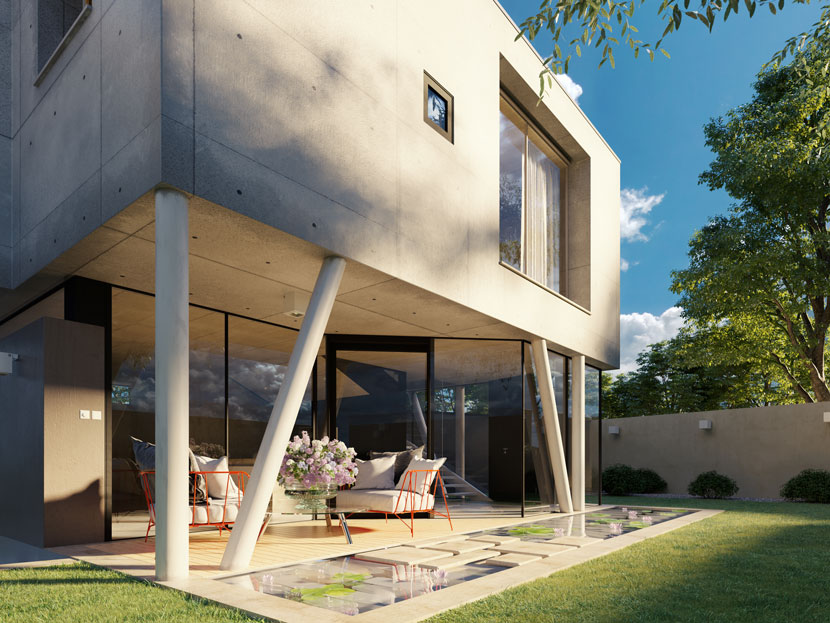 Encouraged by newfound confidence in his abilities, Bogdan completed this exterior as his final project of the SOA masterclass.
Encouraged by newfound confidence in his abilities, Bogdan completed this exterior as his final project of the SOA masterclass.
Before we dive deeper into your latest literary endeavors, I’d like to ask more you about your profession as an archviz artist. Can you briefly summarize your professional career thus far?
Hmmm, to put it into just one word: rollercoaster.
Looking back, there were so many moments when people wouldn’t give me a chance and simply didn’t understand what I was about. My ultimate goal has always been to reach a level of realism, which I refer to as “photo real images”, not to be confused with photorealism, as I wanted to create photos on the pc!
I did a lot of graphic design in various software such as Photoshop, Illustrator, InDesign and many more. At first, I hated these programs with all of my heart, which eventually turned into a love-hate relationship, as I slowly began to appreciate these tools for what they are, and over the years, they have served me well.
To summarize a bit, until 2015, I worked at different advertising companies, while doing 3D in my free time out of passion. In the following years, I started to actually work as an archviz artist, making 3D interiors and exteriors, both as an employee and as a freelancer.
From 2017 to 2018, I was part of TurboSquid, where I worked as a checkmate inspector, but I quickly found out that this kind of routine work was not for me, so I started seeking new challenges and projects. This was a very busy period in my life, with me balancing a full-time and a part-time job as well as several side projects. Due to personal reasons, I had put myself into a state of mind where I wanted to hide in my work, which was not a feasible or healthy thing in the long run.
What were some of your personal highlights in your working life?
One of the most important projects that I was part of was the conception of a wind tunnel, a very challenging undertaking that pushed my modeling skills to the limit.
I did UVW mapping for some NASCAR vehicles, which really got my hands dirty and truly made me internalize a core principle of 3D: if it’s taking too much time, you’re clearly doing something wrong!
When learning on your own, it’s hard to have faith in yourself and in what you are doing – I was still chasing the idea of making realistic renders and SOA was my ultimate goal for achieving this. In my mind, the idea was that once there, I would learn to finally make all of the amazing and cool renders that I had been dreaming of. After one month of intense training, however, I understood that besides some minor things here and there, I had already achieved this level after all. Still, I don’t consider this a waste of time or funds at all, since my time at SOA gave me a much needed confidence boost, fueling my future plans!
What services do you provide?
Since the release of GTAPR, my time has become rather limited, so at this point, I’m balancing being an author and a 3D artist. I have some long-time clients in Malta, Hungary and the U.S., for whom I mostly do interior renders. In Romania, there are a couple of clients for which I regularly do product shots.
 The work on NASCAR vehicles such as the one pictured above taught Bogdan a valuable lesson about time management.
The work on NASCAR vehicles such as the one pictured above taught Bogdan a valuable lesson about time management.
Is there a specific design philosophy or architectural school of thought you adhere to? How would you describe your approach to archviz?
Over the years, archviz shaped me to a point where I’m now unable to look at buildings without observing the light, the mood and wondering in the back of my mind how I could create that inside a software. It’s like I developed an instinct that subconsciously searches for new ways of improving my art all the time. In short, archviz is my life and my archviz philosophy defined how my life is now.
Generally speaking, what is your main goal when doing architectural visualization scenes? What is your personal standard?
Before SOA, I believed that making an image as realistic as possible should be the be-all and end-all in all archviz. But after completing that masterclass, I started to understand that it’s more than that and images should speak and express a state of mind, a state of being. Archviz is a never-ending expression in terms of styles and provides infinite ways to tell “stories”! Building 3D worlds is one of the greatest art forms of our time, and we, as artists, bare a big responsibility in creating the right “language”.
What inspires you as a 3D artist?
As mentioned in the beginning, I was involved with various forms of art from an early point in my life and dedicating myself to art has been and it still is amazing. Over the years, I’ve adhered to what I like to call a “minimalist” lifestyle: eating healthy, sleeping sufficiently, getting out in nature, being a better person each day, and most importantly, let things happen as I believe that they’re meant to. The reason I bring this up is this: living this way and letting life manifest itself around me, I can see and feel the beauty of life in each leaf that is carried by the wind as well as in the noise of the bustling city; art can be found everywhere and we, as 3D artists, are simply “decoding” and reinterpreting the world around us. To me, maintaining a minimalist lifestyle and a harmonious relationship with the spectacle of life as a whole, is fundamental in being a better artist!
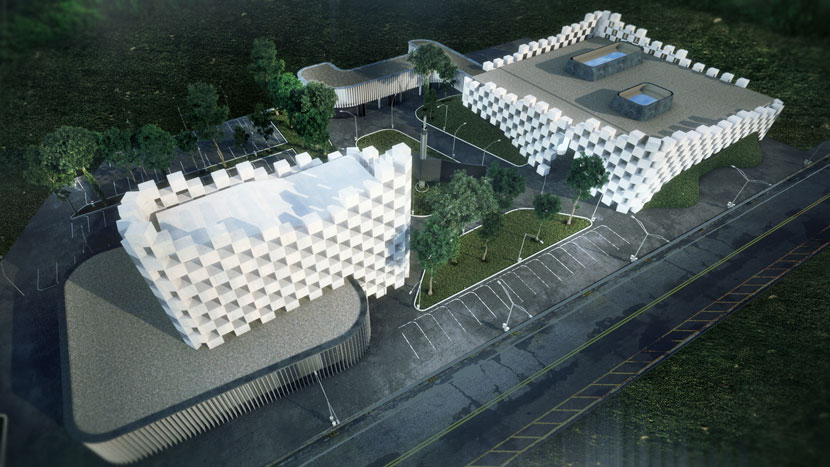 This visualization of a wind tunnel pushed Bogdan’s modeling skills to the limit.
This visualization of a wind tunnel pushed Bogdan’s modeling skills to the limit.
Now, let’s talk about ‘Great Talks about Photo Realism’, or GTAPR for short, your fresh off the press book telling the stories behind some of the world’s most renowned visualization artists. When and how did the idea of this project first emerge in your mind?
It all started with not being satisfied with my renders somewhere between 2015 and 2017. I had already exhausted most of the available learning resources out there, yet still I sensed that something was missing. To me, this perceived lack was very apparent in a lot of my final images, which I deemed dull and fake. During this constant search for more, a thought emerged: maybe if I talked with some household names from the industry, the ones who had already uncovered these secrets, I could get to the bottom of this thing. While I was convinced that these exchanges would certainly help me improve, I had no idea how to contact or approach the people I had in mind.
I let the idea linger for a while, but the thought kept bugging me. Eventually, I understood that this problem was bigger than me, that every new artist faces the same issues and shares this frustration, and that “talking” with established artists would be beneficial to a lot of people. This realization led to the idea of the book, not only for fellow artists, but to show the beauty of 3D art to everybody.
Slowly, I began putting more and more effort into the idea, contacting some amazing artists to gauge their interest. It took some time, but finally Johannes Lindqvist responded positively to one of my emails! After a few weeks, he provided me with everything needed to make the first chapter, which would then serve as demo in the future.
Where did you go from there? How long did it take you to complete the book?
While the idea for the book developed over the course of several years, once everything was in place, the actual work took less than six months!
As mentioned before, Johannes was the first to provide me with the materials for Chapter 1. From there, thanks to my experience in graphic design, I created the layout for the cover and the actual chapter as well. The next challenge was to convince other artists to participate, and to find a publishing house to print and market the book. At least, that was the idea…
Months went by without significant progress, and for the first time, I thought of the possibility of failure. Frustrated with rejections, I had stopped writing emails and was losing focus. Soon after, I met my now-wife Alexandra, who rekindled my passion for the project. When she saw me watching a clip of Fabio Palvelli on YouTube, she said: “why don’t you contact him for the book?”. My initial reaction was: “why? Just to get another no? No, thanks!” But in the days that followed, I reconsidered her suggestion and came to the conclusion that I had nothing to lose.
Fast forward to January 2019, and things started happening fast. Fabio replied, he really liked the idea, and offered his help in getting me in touch with other artists. All of a sudden, the book was about to become a reality! What followed were some very intense months of work; Fabio wanted to make sure that the book would be a quality product, so we set up a personal meeting. At the end of March 2019, I went to Rome and presented him the unfinished book. He was amazed by the layout and the quality of print, and his approval greatly motivated me to push forward.
How would you describe your main motivation behind GTAPR?
In the beginning, I just followed my instincts. Once the idea started to take shape, I realized that putting together the book was yet another process of creation and personal expression. So, my motivation remains the same as for everything I do: art always is in my blood, it always has been and always will be, and if I can help showcase the beauty and greatness of what 3D art is, I’m all in, every time!
Did you have previous experience as an author? How did you make the transition from a 3D artist to a writer and editor?
No, before GTAPR I had no idea what it meant to be an author. Once the book picked up speed, I started to balance 3D work with my involvement in the marketing of the book, so at this point the main reason I’m still doing 3D at all, is because I like it so much!
What were the biggest challenges you had to overcome?
There was so much I had to learn from the ground up! From setting up the website, to implementing a payment and shipping system, there was a constant flow of minor and major problems waiting to be solved. Although I’ve assembled a small team to help me, the biggest challenges like marketing and PR was still entirely on me. Luckily, I’ve never been afraid of innovating or dreaming big, and the successful release of GTAPR has only confirmed me in my belief that everything will turn out ok!
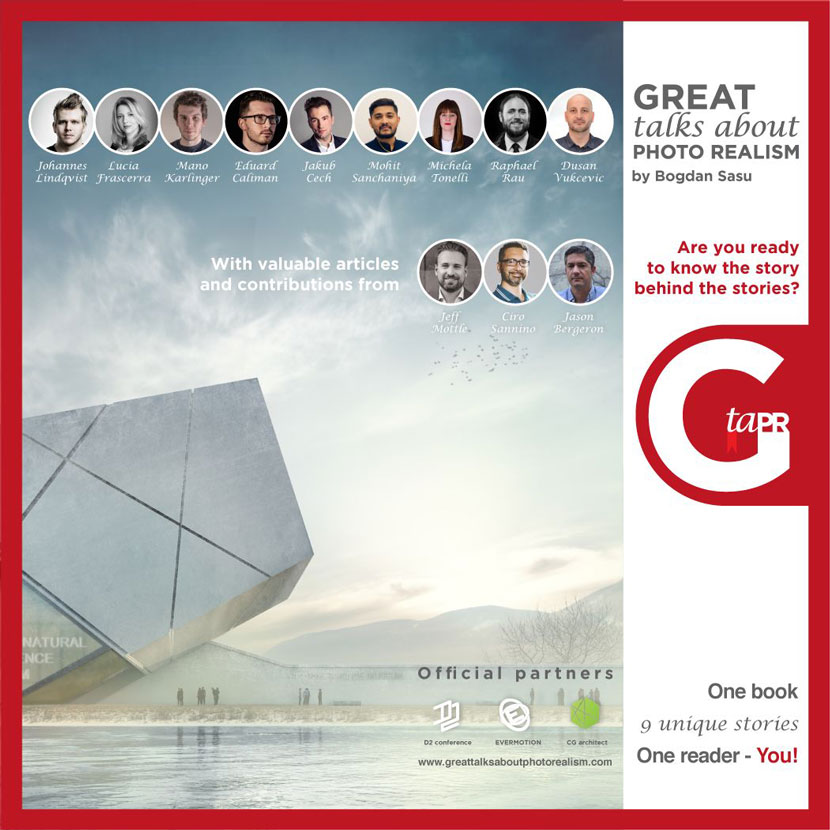 This promotional slide shows the talented artists featured in the first volume of GTAPR.
This promotional slide shows the talented artists featured in the first volume of GTAPR.
Give us the rundown on the content of GTAPR!
The book is A4 standard format (210x297mm), it has 200 pages and is structured as a series of interviews with the artists. It is prefaced by three articles: an introduction by Jeff Mottle, founder and CEO of CGarchitect, 3D artist, architect and community figurehead Jason Bergeron writing on ‘The Importance of Community’, and author and V-Ray expert Ciro Sanino’s ‘The importance of light’.
The main body of the book consists of nine chapters, each dedicated to one of the following artists (in order of appearance): Johannes Lindqvist, Lucia Frascerra, Manó Karlinger, Eduard Caliman, Jakub Čech, Mohit Sanchaniya, Michela Tonelli, Raphael Rau and Dušan Vukčević.
Each chapter is equally divided into part text and part renders.
What can we expect in terms of print quality?
The print is really good, it’s definitely up to par with any professional photography book or coffee table book out there. The artists all were impressed by the print quality, some of them even told me the renders looked better than on the screen! In technical terms, the paper is semi-matte 170g on the inside and hardcover glossy on the outside.
The book unites archviz artists and industry experts from all over the world. How did you manage a project of this scale?
As stated before, none of this would’ve been possible without Fabio and his continuous support. He believed in the project from the beginning and put a lot of effort into motivating other artists to be a part of GTAPR. He was also the one responsible for our partnership with Evermotion and the articles that preface the book!
Who is the target audience for the book?
I wanted to create a product for both the industry as well as a general audience, meaning people that have no prior knowledge of what goes into the production of 3D images. The idea was twofold: first, to showcase the artists and their work for the community and provide professional insights along with digital 3D scenes to be used and studied, and second, show the world how amazing this domain is and what exactly is behind – modeling, texturing and so on.
In reality, after releasing the book, most of the uninformed crowd looked at GTAPR as a photography book. Each time I explain that the images are in fact done on the computer, I receive reactions varying from amazement to shock, and even denial. I’ve gotten used to this though, and all jokes aside, I feel proud to raise awareness for the CGI artform!
Where can the book be purchased?
Currently, the book can be purchased exclusively through our official site. However, we are working hard to make GTAPR available on Amazon as well as at selected book shops in the future. We also offered the option to pick up your copy at specific industry events we attend, as to avoid shipping fees.
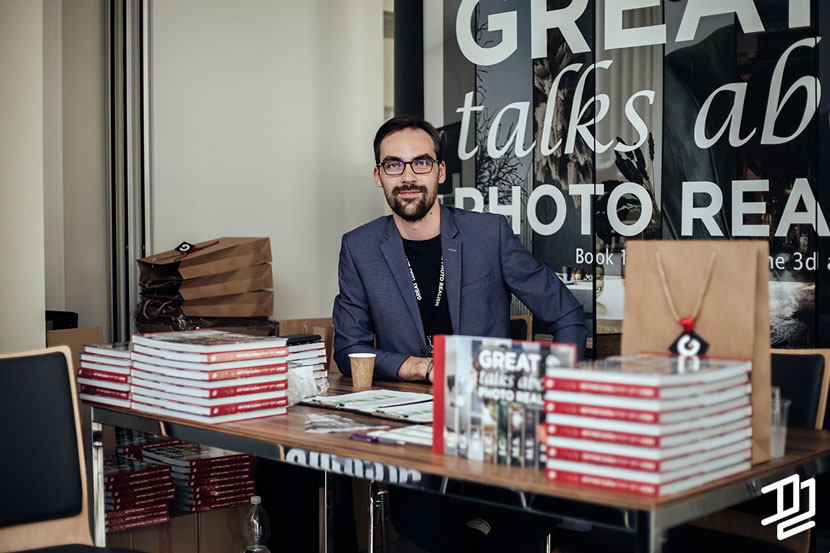 The proud author and his brainchild at the D2 conference 2019 in Vienna, Austria. Photo by Romar Ferry.
The proud author and his brainchild at the D2 conference 2019 in Vienna, Austria. Photo by Romar Ferry.
Transcending the analogue medium, you paired the book with exclusive digital content such as scenes and assets. Please tell us more about this decision and the additional content itself!
The idea of creating and offering exclusive scenes came to us naturally. Fabio and I decided that having just the printed renders would be too little for aspiring artists, who might want to study the framing, lighting and so on in more detail. The solution we came up with was to ask the artists from the book to create 3D interior and exterior scenes, using models from our partner Evermotion as well as original assets made by the artists themselves. Due to very busy schedules of some of the artists, we unfortunately missed the mark on having nine scenes, but the seven scenes we do provide are of the highest quality and an excellent addition to the book!
Having completed such an ambitious task, how was it to finally hold the book in your own hands?
It was spectacular! I remember my contact at our printing company sending me preview pages, and just a few days later, when I held the assembled book in my hands, I was overcome with joy and satisfaction!
What has the initial feedback been like?
Shortly after the book was published, we had the opportunity to present our work at the D2 conference, the biggest event in the archviz industry. People simply loved it and I had the chance to see their live reaction and gather a lot of direct feedback. It was overwhelming and a bit surreal, I remember standing there with the team, feeling like I was dreaming.
 After all this time, it’s finally here! For Bogdan, holding a copy of his book in his own hands is like a dream come true.
After all this time, it’s finally here! For Bogdan, holding a copy of his book in his own hands is like a dream come true.
We are thrilled to announce a partnership between GTAPR and RebusFarm! Would you do us the honor and explain what we have in store for our community?
Sure, it’s great to have RebusFarm as a partner! To express our deepest respect and appreciation for what you guys do for the industry, we want to support the community by gifting a free copy of GTAPR to every winner of the 3D Artist of the Month competition. We are sure that together, we can increase the awareness for the CG industry even further!
Considering the book is categorized as ‘Volume 1’, what can you reveal regarding future plans for GTAPR as a potential series?
My initial plans for the series were somewhat convoluted. Originally, I wanted to explore the archviz and CG industry through different lenses, with each volume focusing on a specific perspective, such as artists, studios and so on. However, now that we have successfully established a brand for GTAPR, we decided to break things up and release a similar product focused only on 3D studios under a separate name: we are already in talks with various companies to realize ‘Stories from the Office – A Book about Archviz’!
Meanwhile, we are working on GTAPR Volume II, which will have another great lineup of nine fantastic artists. We have already entered production and plan on publishing by July 1st, the book has just gone up for pre-sale on our site!
Finally, GTAPR as a whole has significantly impacted me in multiple ways and led to even bigger ideas! Fabio and I started The Juice Bar, a site that will hopefully evolve into one of the important online landmarks of the industry, providing books dedicated to archviz, CGI and art in general. Under the motto “where creatives come to hang out”, we want to make a resourceful place, where artists can find inspiration and unite to celebrate art in all of its forms.
Sounds like we have a lot to look forward to! Bogdan, thank you so much for taking the time and all the best for your future endeavors.
Check out Great Talks About Photo Realism here:
>> Read more articles on our blog
